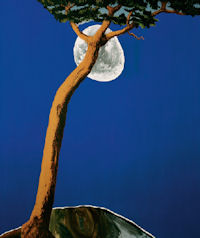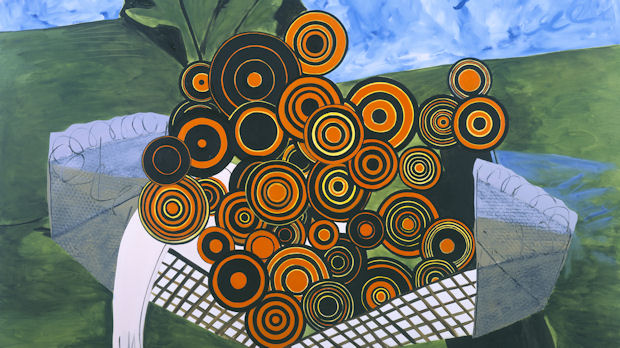Turner Prize 10: Dexter Dalwood
Dexter Dalwood’s paintings draw upon recent historical events, using collage techniques to create portraits “without the person there”. He is one of two painters in the running for Turner Prize 10.

Dexter Dalwood has been nominated for Turner Prize 10 for his solo exhibition at Tate St Ives which “revealed the rich depth and range of his approach to making painting that draws upon historical tradition as well as contemporary cultural and political events”.
Dalwood was born Bristol in 1960 and studied at Central St Martins and the Royal College of Art in the 1980s. He now lives and works in London.
Dalwood’s cut and paste techniques play with the idea of a splintered reality, that there is no single version of it and that our understanding of the past and present is made up of different memories and viewpoints.
Working with found imagery, Dalwood creates layered paintings to portray individuals or events that have shaped recent history, culture and society – using fragments of stories, images and perspectives.
3 Minute Wonder on Channel 4 until 9 December (Courtesy: Tate Media)
One of Dalwood’s paintings examines the death of Dr David Kelly, the government scientist found dead after the Iraq war dossier furore, another the Brighton hotel bombing at the Tory party conference in 1984.
More on Dexter Dalwood from Turner Prize 10
He is also inspired by literary figures, for example William Burroughs in Burroughs in Tangiers and Moby Dick author Herman Melville. At the Turner Prize show these works are displayed along with a new painting, White Flag 2010, a vivid yet sideways glance at the fallout of the Iraq war. Washed out stars and stripes hover over a pseudo-Islamic scene, featuring a Hookah pipe, said to have been inspired by a video game.
‘A portrait of someone without the person there’
“You do travel to see paintings, well I do anyway,” says Dalwood.
He explains: “It’s that whole idea that you go and look at a painting somewhere and then, what it does to you and how you think about it after seeing it, how the ramifications of it continue… I think that paintings can do that.
“I think that the best painting stays with you.”

(The Death of Doctor David Kelly, 2008. Courtesy: Gagosian Gallery. Photo: Dave Morgan)
“I think with the death of David Kelly, at the time I thought quite a lot about it. It seems a very tragic case that someone was vilified and then died. And then making the painting it distilled down into the tree and the moon and the little mound, with the blue becoming, hopefully, the emotional thump to it.”
“It’s having to find a balance as the quietness, in a way, of how I think painting can function. It’s not a ticking off of all the things that need to be in there. And it’s also not forensic. It’s trying to get beyond that… make it kind of mythic in some way.”

(Greenham Common, 2008. Courtesy: Gagosian Gallery. Photo: Prudence Cuming Associates Ltd)
'You don't have to look much closer to see that there's a twist', writes Matthew Cain
At first glance, the work of Dexter Dalwood is the most traditional on the list.
His paintings seem to be straightforwardly representational and have plainly descriptive, factual titles. But you don't have to look much closer to see that there's a twist; the individual or situation each painting claims to describe is actually absent from the painting.
So each piece has a strong representational image but at the same time makes you think about another image altogether. For me it's this tension between presence and absence that makes the work special. The paintings invite you to ponder on how the portrayal of individuals or events through history is fundamentally an amalgamation of fragmented stories, images and points of view.
So the work is representational yet invites us to question the accuracy of one true representation at the same time.
What I love about the paintings is this sense of possibility they suggest. The way that I interpret them, they're fundamentally positive works, even if some of the subject matter may not at first appear to be so. e.g. The Death of David Kelly.
But perhaps what I find the most striking is that they don't lack warmth or the possibility for emotional engagement; I'd expected the opposite when I read the catalogue and discovered that the protagonists are absent from the work. Thankfully, this is most definitely not the case.
It's also important to point out here that although the paintings are layered with historical and cultural references, at the same time you dont need any kind of art history manual to decode them. You can simply enjoy them as beautifully composed paintings.
Or, if you'd like to, you can work a bit harder and discover extra layers of meaning. But however you choose to approach them, the paintings are very rewarding.
-
Latest news
-
As India goes to the polls in the world’s largest election – what do British-Indians think?6m

-
Tees Valley: Meet the candidates in one of the biggest contests coming up in May’s local elections4m

-
Keir Starmer says public sector reform will be a struggle7m

-
Nicola Sturgeon’s husband Peter Murrell charged with embezzlement of funds from SNP1m

-
Ukraine might finally get $60billion in American weapons and assistance to defend against Russia3m

-




